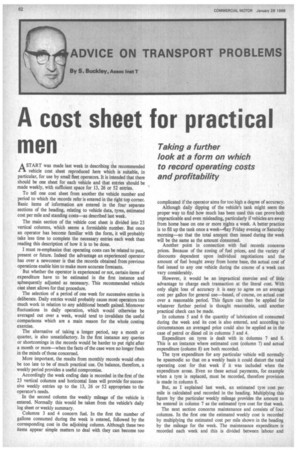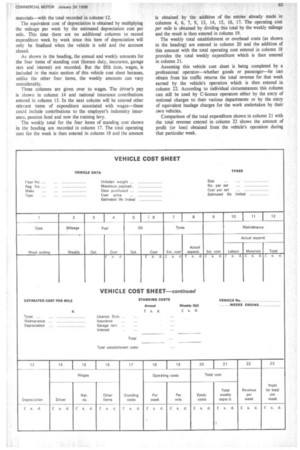A cost sheet for practical men
Page 64

Page 65

If you've noticed an error in this article please click here to report it so we can fix it.
ASTART was made last week in describing the recommended vehicle cost sheet reproduced here which is suitable, in particular, for use by small fleet operators. It is intended that there should be one sheet for each vehicle and that entries should be made weekly, with sufficient space for 13, 26 or 52 entries.
To tell one cost sheet from another the vehicle number and period to which the records refer is entered in the right top corner. Basic items of information are entered in the four separate sections of the heading, relating to vehicle data, tyres, estimated cost per mile and standing costs—as described last week.
The main section of the vehicle cost sheet is divided into 23 vertical columns, which seems a formidable number. But once an operator has become familiar with the form, it will probably take less time to complete the necessary entries each week than reading this description of how it is to be done.
I must re-emphasize that operating costs can be related to past, present or future. Indeed the advantage an experienced operator has over a newcomer is that the records obtained from previous operations enable him to make more accurate forecasts.
But whether the operator is experienced or not, certain items of expenditure have to be estimated in the first instance and subsequently adjusted as necessary. This recommended vehicle &1st sheet allows for that procedure.
The selection of a period of one week for successive entries is deliberate. Daily entries would probably cause most operators too much work in relation to any additional benefit gained. Moreover fluctuations in daily operation, which would otherwise be averaged out over a week, would tend to invalidate the useful comparisons which are a main reason for the whole costing exercise.
The alternative of taking a longer period, say a month or quarter, is also unsatisfactory. In the first instance any queries or shortcomings in the records would be harder to put right after a month or more—when the facts of the case were no longer fresh in the minds of those concerned.
More important, the results from monthly records would often be too late to be of much practical use. On balance, therefore, a weekly period provides a useful compromise.
Accordingly the week ending date is recorded in the first of the 23 vertical columns and horizontal lines will provide for successive weekly entries up to the 13, 26 or 52 appropriate to the operator's needs.
In the second column the weekly mileage of the vehicle is entered. Normally this would be taken from the vehicle's daily log sheet or weekly summary.
Columns 3 and 4 concern fuel. In the first the number of gallons consumed during the week is entered, followed by the corresponding cost in the adjoining column. Although these two items appear simple matters to deal with they can become too complicated if the operator aims for too high a degree of accuracy.
Although daily dipping of the vehicle's tank might seem the proper way to find how much has been used this can prove both impracticable and even misleading, particularly if vehicles are away from home base on one or more nights a week. A better practice is to fill up the tank once a week—ciay Friday evening or Saturday morning—so that the total amount then issued during the week will be the same as the amount consumed.
Another point in connection with fuel records concerns prices. Because of the zoning of fuel prices, and the variety of discounts dependent upon individual negotiations and the amount of fuel bought away from home base, the actual cost of fuel issued to any one vehicle during the course of a week can vary considerably.
However, it would be an impractical exercise and of little advantage to charge each transaction at the literal cost. With only slight loss of accuracy it is easy to agree on an average cost per gallon for general use—based, of course, on actual cost over a reasonable period. This figure can then be applied for whatever further period is thought reasonable, until another practical check can be made.
In columns 5 and 6 the quantity of lubrication oil consumed during the week and its cost is also entered, and according to circumstances an averaged price could also be applied as in the case of petrol or diesel oil in columns 3 and 4.
Expenditure on tyres is dealt with in columns 7 and 8. This is an instance where estimated cost (column 7) and actual expenditure (column 8) are both recorded.
The tyre expenditure for any particular vehicle will normally be spasmodic so that on a weekly basis it could distort the total operating cost for that week if it was included when the expenditure arose. Even so these actual payments, for example when a tyre is replaced, must be recorded, therefore provision is made in column 8.
But, as I explained last week, an estimated tyre cost per mile is calculated and recorded in the heading. Multiplying this figure by the particular weekly mileage provides the amount to be entered in column 7 as the estimated tyre cost for that week.
The next section concerns maintenance and consists of four columns. In the first one the estimated weekly cost is recorded by multiplying the estimated cost per mile shown in the heading by the mileage for the week. The maintenance expenditure is recorded each week and this is divided between labour and materials—with the total recorded in column 12.
The equivalent cost of depreciation is obtained by multiplying the mileage per week by the estimated depreciation cost per mile. This time there are no additional columns to record expenditure week by week since this item of depreciation will only be finalized when the vehicle is sold and the account closed.
As shown in the heading, the annual and weekly amounts for the four items of standing cost (licence duty, insurance, garage rent and interest) are recorded. But the fifth item, wages, is included in the main section of this vehicle cost sheet because, unlike the other four items, the weekly amounts can vary considerably.
Three columns are given over to wages. The driver's pay is shown in column 14 and national insurance contributions entered in column 15. In the next column will be entered other relevant items of expenditure associated with wages—these could include contributions to the employer's indemnity insurance, pension fund and now the training levy.
The weekly total for the four items of standing cost shown in the heading are recorded in column 17. The total operating cost for the week is then entered in column 18 and the amount
is obtained by the addition of the entries already made in columns 4, 6, 7, 9, 13, 14, 15, 16, 17. The operating cost per mile is obtained by dividing this total by the weekly mileage and the result is then entered in column 19.
The weekly total establishment or overhead costs (as shown in the heading) are entered in column 20 and the addition of this amount with the total operating cost entered in column 18 provides the total weekly expenditure which is then entered in column 21.
Assuming this vehicle cost sheet is being completed by a professional operator—whether goods or passenger—he can obtain from his traffic returns the total revenue for that week earned by the vehicle's operation which is then entered in column 22. According to individual circumstances this column can still be used by C-licence operators either by the entry of notional charges to their various departments or by the entry of equivalent haulage charges for the work undertaken by their own vehicles.
Comparison of the total expenditure shown in column 21 with the total revenue entered in column 22 shows the amount of profit (or loss) obtained from the vehicle's operation during that particular week.












































































































